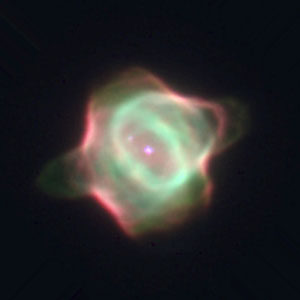
Planetary Nebulae
Planetary Nebulae differ from H II regions in that they are more compact and have a higher surface brightness, as well as having a different exciting source. Through a telescope they look like a round greenish disk which resembles a planet, hence the name! Close examination of these regions has shown that they must have a very hot central star. The gas densities of these nebulae are higher than H II regions so collision between electrons, atom and ions are more frequent. Therefore the effects of collisional excitation and de-excitation will be more significant, causing emission from forbidden lines. Below is picture of the Stingray Nebula, it is the youngest known Planetary Nebula in the Universe:

As can be observed above large shells are visible and from using emission lines we can show that they are expanding at a rate of tens of kilometres a second. This is the reason that very few planetary nebulae are known as they have such short (on a relative scale) life times (50,000years).